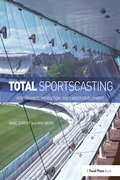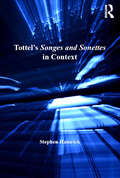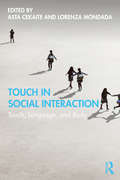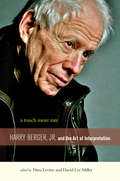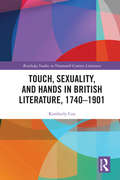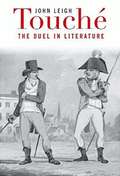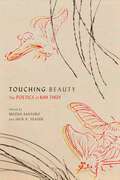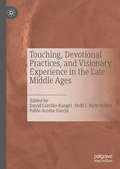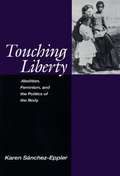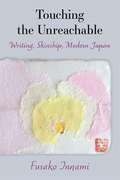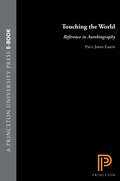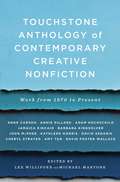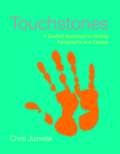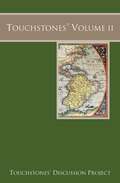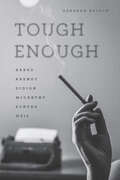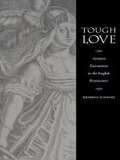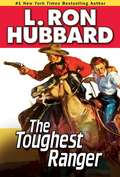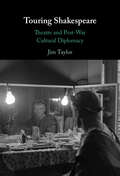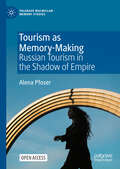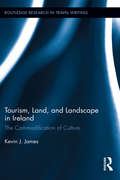- Table View
- List View
Total Sportscasting: Performance, Production, and Career Development
by Max Negin Marc ZumoffWhether you want to be in front of the camera, on the microphone, or behind the scenes, Total Sportscasting gives you the skills you'll need to become successful in this dynamic industry. This book covers everything from performance and production techniques to all aspects of sportscasting, good broadcast writing techniques, and how best to forge lasting relationships with team personnel. It also delves into the unique issues facing women sportscasters. And when it comes to breaking into the business, Total Sportscasting devotes entire chapters to career development and demo reel production. For important perspective, we've also included chapters on the history of sportscasting and attempts to glimpse into its future. Total Sportscasting is packed with a variety of features for both learning and instructing: Complete coverage of every aspect of the sportscast, helping you prepare for any platform--TV, radio, and the web Interviews with successful sports journalists, producers, and directors who give you an inside look into the real-world practices of the industry A companion website, which provides additional resources for both instructors and students, including video and audio examples and links to additional resources: www.totalsportscasting.com
Totality Inside Out: Rethinking Crisis and Conflict under Capital
by Kevin Floyd, Jen Hedler Phillis, and Sarika ChandraHowever divergent their analyses may be in other ways, some prominent anti-capitalist critics have remained critical of contemporary debates over reparative justice for groups historically oppressed and marginalized on the basis of race, gender, sexual identity, sexual preference, and/or ability, arguing that the most these struggles can hope to produce is a more diversity-friendly capital. Meanwhile, scholars of gender and sexuality as well as race and ethnic studies maintain that, by elevating the socioeconomic above other logics of domination, anti-capitalist thought fails to acknowledge specific forms and experiences of subjugation.The thinkers and activists who appear in Totality Inside Out reject this divisive logic altogether. Instead, they aim for a more expansive analysis of our contemporary moment to uncover connected sites of political struggle over racial and economic justice, materialist feminist and queer critique, climate change, and aesthetic value. The re-imagined account of capitalist totality that appears in this volume illuminates the material interlinkages between discrepant social phenomena, forms of oppression, and group histories, offering multiple entry points for readers who are interested in exploring how capitalism shapes integral relations within the social whole.Contributors: Brent Ryan Bellamy, Sarah Brouillette, Sarika Chandra, Chris Chen,Joshua Clover, Tim Kreiner, Arthur Scarritt, Zoe Sutherland, Marina Vishmidt
Tottel's Songes and Sonettes in Context (Material Readings in Early Modern Culture)
by Stephen HamrickThough printer Richard Tottel’s Songes and Sonettes (1557) remains the most influential poetic collection printed in the sixteenth century, the compiliation has long been ignored or misundertood by scholars of early modern English culture. Embracing a broad range of critical and historical perspectives, the eight essays within this volume offer the first sustained analysis of the many ways that consumers read and understood Songes and Sonettes as an anthology over the course of the early modern period. Copied by a monarch, set to music, sung, carried overseas, studied, appropriated, rejected, edited by consumers, transferred to manuscript, and gifted by Shakespeare, this muti-author verse anthology of 280 poems transformed sixteenth-century English language and culture. With at least eleven printings before the end of Elizabeth I’s reign, Tottel’s ground-breaking text greatly influenced the poetic publications that followed, including individual and multi-author miscellanies. Contributors to this essay collection explore how, in addition to offering a radically new kind of English verse, ’Tottel’s Miscellany’ engaged politics, friendship, religion, sexuality, gender, morality and commerce in complex-and at times, contradictory-ways.
Touch a Dream
by Harcourt School Publishers StaffEverybody has a dream. Some dreams are simple; some are grand. Dreams are those special hopes that we aim for. What's your dream? In Touch a Dream, you will read about people reaching for their biggest goals and making them happen. Some of these people travel to new lands to study rare plants and animals, or to find a new home. Others simply plant a small garden in their city neighborhood. You'll discover some people who help those around them, while others strive to meet their own goals. Every time you read a different story, you will discover a new dream.
Touch and Intimacy in First World War Literature
by Santanu DasWar writing is haunted by experiences of physical contact: from the muddy realities of the front to the emotional intensity of trench life. Through extensive archival and historical research, analyzing previously unknown letters and diaries alongside literary writings by figures such as Owen and Brittain, Santanu Das recovers the sensuous world of the First World War trenches and hospitals. This original and evocative study alters our understanding of the period as well as of the body at war, and illuminates the perilous intimacy between sense experience, emotion and language as we try to make meaning in times of crisis.
Touch in Social Interaction: Touch, Language, and Body
by Asta Cekaite Lorenza MondadaRooted in multimodal conversation analysis and based on video recordings of naturally occurring social interactions, this book presents a novel analytical perspective for the study of touch. The authors focus on how different forms of touch are interactionally organized in everyday, institutional, and professional practices, showing how touch is multimodally achieved in social interaction, how it acquires its significance, how it is embedded in the current activity and in its social context, and how it is systematically intertwined with talk, facial expressions, and body posture. Including work by a wide range of renowned researchers, this volume provides rich visual illustrations of situations featuring touch as a social and intersubjective practice. The studies make a compelling contribution to the field by clearly examining and demonstrating the social meaning of touch for the participants in social interaction in a broad range of contexts. Presenting a new methodology for the study of touch, this is key reading for all researchers and scholars working in conversation analysis, multimodality, and related areas.
A Touch More Rare: Harry Berger, Jr., and the Arts of Interpretation
by Harry BergerHarry Berger, Jr., has long been one of our most revered and respected literary and cultural critics. Since the late nineties, a stream of remarkable and innovative publications have shown how very broad his interests are, moving from Shakespeare to baroque painting, to Plato, to theories of early culture.In this volume a distinguished group of scholars gathers to celebrate the work of Harry Berger, Jr. To "celebrate," in Berger's words, is "to visit something either in great numbers or else frequently-to go away and come back, go away and come back, go away and come back. Celebrating is what you do the second or third time around, but not the first. To celebrate is to revisit. To revisit is to revise. Celebration is the eureka of revision." Not only former students but distinguished colleagues and scholars come together in these pages to discover Berger's eurekas-to revisit the rigor and originality of his criticism, and occasionally to revise its conclusions, all through the joy of strenuous engagement. Nineteen essays on Berger's Shakespeare, his Spenser, his Plato, and his Rembrandt, on his theories of interpretation and cultural change and on the ethos of his critical and pedagogical styles, open new approaches to the astonishing ongoing body of work authored by Berger. An introduction by the editors and an afterword by Berger himself place this festival of interpretation in the context of Berger's intellectual development and the reception of his work from the mid-twentieth century into the first decade of the twenty-first.
Touch, Sexuality, and Hands in British Literature, 1740–1901 (Routledge Studies in Nineteenth Century Literature)
by Kimberly CoxFrom Robert Lovelace’s uninvited hand grasps in Samuel Richardson’s Clarissa to Jane Eyre’s sexual awakening at Edward Rochester’s embrace to Basil Hallward’s first encounter with Dorian Gray, literary depictions of touching hands in British literature from the 1740s to the 1890s communicate emotional dimensions of sexual experience that reflect shifting cultural norms associated with gender roles, sexuality, and sexual expression. But what is the relationship between hands, tactility, and sexuality in Victorian literature? And how do we interpret what those touches communicate between characters? This volume addresses these questions by asserting a connection between the prevalence of violent, sexually charged touches in eighteenth-century novels such as those by Eliza Haywood, Samuel Richardson, and Frances Burney and growing public concern over handshake etiquette in the nineteenth century evident in works by Jane Austen, the Brontës, George Eliot, Elizabeth Gaskell, Thomas Hardy, Oscar Wilde, and Flora Annie Steel. This book takes an interdisciplinary approach that combines literary analysis with close analysis of paintings, musical compositions, and nonfictional texts, such as etiquette books and scientific treatises, to make a case for the significance of tactility to eighteenth- and nineteenth-century perceptions of selfhood and sexuality. In doing so, it draws attention to the communicative nature of skin-to-skin contact as represented in literature and traces a trajectory of meaning from the forceful grips that violate female characters in eighteenth-century novels to the consensual embraces common in Victorian and neo-Victorian literature.
Touché: The Duel in Literature
by John LeighMany of the West's best writers fought in duels or wrote about them, seduced by glamour or risk or recklessness. A gift as a plot device, the duel also offered a way to discover how we face fears of humiliation, pain, and death. John Leigh's literary history of the duel illuminates these and other tensions attending the birth of the modern world.
Touching Beauty: The Poetics of Kim Thúy
by Miléna SantoroKim Thúy is a literary phenomenon, rising in her first decade of writing to a level of international recognition that few Québécois writers ever attain. The Vietnamese-born author’s novels have garnered literary prize recognition and have been translated from French into twenty-nine languages in nearly forty countries.Touching Beauty is the first collection to focus solely on Thúy and her economical yet poetic storytelling style that expresses both the traumatic and the beautiful. Her writings, which manage to be culturally specific all while speaking to the fundamentals of the human condition, are examined within the context of what is known as migrant literature in Canada and are situated within the history of Vietnamese literature in French that grew out of the colonial period. Chapters explore food, identity, gender, and the role of writing in Thúy’s life and work. Thúy herself contributes an unpublished poem and an extended interview that focus on her ongoing struggle to find, and write, beauty amidst war, migration, poverty, and loss. Touching Beauty maps the themes that have, to date, animated a literary career of global relevance and enduring value and encourages a deeper appreciation of Thúy’s writing.
Touching, Devotional Practices, and Visionary Experience in the Late Middle Ages
by David Carrillo-Rangel Delfi I. Nieto-Isabel Pablo Acosta-GarcíaThis book addresses the history of the senses in relation to affective piety and its role in devotional practices in the late Middle Ages, focusing on the sense of touch. It argues that only by deeply analysing this specific context of perception can the full significance of sensory religious experience in the Late Middle Ages be understood. Considering the centrality of the body to medieval society and Christianity, this collection explores a range of devotional practices, mainly relating to the Passion of Christ, and features manuscripts, works of devotional literature, art, woodcuts and judicial records. It brings together a multidisciplinary group of scholars to offer a variety of methodological approaches, in order to understand how touch was encoded, evoked and purposefully used. The book further considers how touch was related to the medieval theory of perception, examining its relation to the inner and outer senses through the eyes of visionaries, mystics, theologians and confessors, not only as praxis but from different theoretical points of view. While considered the most basic of spiritual experience, the chapters in this book highlight the all-pervasive presence of touch and the significance of ‘affective piety’ to Late Medieval Christians.Chapter 3: Drama, Performance and Touch in the Medieval Convent and Beyond is Open Access under a CC BY 4.0 license at link.springer.com
Touching Liberty: Abolition, Feminism, and the Politics of the Body
by Karen Sánchez-EpplerIn this study of the pre-Civil War literary imagination, Karen Sánchez-Eppler charts how bodily difference came to be recognized as a central problem for both political and literary expression. Her readings of sentimental anti-slavery fiction, slave narratives, and the lyric poetry of Walt Whitman and Emily Dickinson demonstrate how these texts participated in producing a new model of personhood converged with the sexually distinct and domestically circumscribed female body.
Touching the Unreachable: Writing, Skinship, Modern Japan (Michigan Monograph Series in Japanese Studies #91)
by Fusako InnamiFusako Innami offers the first comprehensive study of touch and skinship—relationality with the other through the skin—in modern Japanese writing. The concept of the unreachable—that is, the lack of characters’ complete ability to touch what they try to reach for—provides a critical intervention on the issue of intimacy. Touch has been philosophically addressed in France, but literature is an effective—or possibly the most productive—venue for exploring touch in Japan, as literary texts depict what the characters may be concerned with but may not necessarily say out loud. Such a moment of capturing the gap between the felt and the said—the interaction between the body and language—can be effectively analyzed by paying attention to layers of verbalization, or indeed translation, by characters’ utterances, authors’ depictions, and readers’ interpretations. Each of the writers discussed in this book—starting with Nobel prize winner Kawabata Yasunari, Tanizaki Jun’ichiro, Yoshiyuki Junnosuke, and Matsuura Rieko—presents a particular obsession with objects or relationality to the other constructed via the desire for touch. In Touching the Unreachable, phenomenological and psychoanalytical approaches are cross-culturally interrogated in engaging with literary touch to constantly challenge what may seem like the limit of transferability regarding concepts, words, and practices. The book thereby not only bridges cultural gaps beyond geographic and linguistic constraints, but also aims to decentralize a Eurocentric hegemony in its production and use of theories and brings Japanese cultural and literary analyses into further productive and stimulating intellectual dialogues. Through close readings of the authors’ treatment of touch, Innami develops a theoretical framework with which to examine intersensorial bodies interacting with objects and the environment through touch.
Touching the World: Reference in Autobiography
by Paul John EakinPaul John Eakin's earlier work Fictions in Autobiography is a key text in autobiography studies. In it he proposed that the self that finds expression in autobiography is in fundamental ways a kind of fictive construct, a fiction articulated in a fiction. In this new book Eakin turns his attention to what he sees as the defining assumption of autobiography: that the story of the self does refer to a world of biographical and historical fact. Here he shows that people write autobiography not in some private realm of the autonomous self but rather in strenuous engagement with the pressures that life in culture entails. In so demonstrating, he offers fresh readings of autobiographies by Roland Barthes, Nathalie Sarraute, William Maxwell, Henry James, Ronald Fraser, Richard Rodriguez, Henry Adams, Patricia Hampl, John Updike, James McConkey, and Lillian Hellman. In the introduction Eakin makes a case for reopening the file on reference in autobiography, and in the first chapter he establishes the complexity of the referential aesthetic of the genre, the intricate interplay of fact and fiction in such texts. In subsequent chapters he explores some of the major contexts of reference in autobiography: the biographical, the social and cultural, the historical, and finally, underlying all the rest, the somatic and temporal dimensions of the lived experience of identity. In his discussion of contemporary theories of the self, Eakin draws especially on cultural anthropology and developmental psychology.
Touchstone Anthology of Contemporary Creative Nonfiction: Work from 1970 to the Present
by Lex Williford Michael MartoneFrom memoir to journalism, personal essays to cultural criticism, this indispensable anthology brings together works from all genres of creative nonfiction, with pieces by fifty contemporary writers including Cheryl Strayed, David Sedaris, Barbara Kingsolver, and more.Selected by five hundred writers, English professors, and creative writing teachers from across the country, this collection includes only the most highly regarded nonfiction work published since 1970. Contributers include: Jo Ann Beard, Wendell Berry, Eula Biss, Mary Clearman Blew, Charles Bowden, Janet Burroway, Kelly Grey Carlisle, Anne Carson, Bernard Cooper, Michael W. Cox, Annie Dillard, Mark Doty, Brian Doyle, Tony Earley, Anthony Farrington, Harrison Candelaria Fletcher, Diane Glancy, Lucy Grealy, William Harrison, Robin Hemley, Adam Hochschild, Jamaica Kincaid, Barbara Kingsolver , Ted Kooser, Sara Levine, E.J. Levy, Phillip Lopate, Barry Lopez, Thomas Lynch, Lee Martin, Rebecca McCLanahan, Erin McGraw, John McPhee, Brenda Miller, Dinty W. Moore, Kathleen Norris, Naomi Shihab Nye, Lia Purpura, Richard Rhodes, Bill Roorbach, David Sedaris, Richard Selzer, Sue William Silverman, Floyd Skloot, Lauren Slater, Cheryl Strayed, Amy Tan, Ryan Van Meter, David Foster Wallace, and Joy Williams.
Touchstones: A Guided Approach to Writing Paragraphs and Essays
by Chris Juzwiak"Touchstones," is a paragraph-to-essay level book that begins with a focus on academic paragraphs and essays, then moves to higher-level skills such as using precise language and working with sources.
Tough Enough: Arbus, Arendt, Didion, McCarthy, Sontag, Weil
by Deborah NelsonThis book focuses on six brilliant women who are often seen as particularly tough-minded: Simone Weil, Hannah Arendt, Mary McCarthy, Susan Sontag, Diane Arbus, and Joan Didion. Aligned with no single tradition, they escape straightforward categories. Yet their work evinces an affinity of style and philosophical viewpoint that derives from a shared attitude toward suffering. What Mary McCarthy called a “cold eye” was not merely a personal aversion to displays of emotion: it was an unsentimental mode of attention that dictated both ethical positions and aesthetic approaches. Tough Enough traces the careers of these women and their challenges to the pre-eminence of empathy as the ethical posture from which to examine pain. Their writing and art reveal an adamant belief that the hurts of the world must be treated concretely, directly, and realistically, without recourse to either melodrama or callousness. As Deborah Nelson shows, this stance offers an important counter-tradition to the familiar postwar poles of emotional expressivity on the one hand and cool irony on the other. Ultimately, in its insistence on facing reality without consolation or compensation, this austere “school of the unsentimental” offers new ways to approach suffering in both its spectacular forms and all of its ordinariness.
Tough Love: Amazon Encounters in the English Renaissance
by Kathryn SchwarzIn Tough Love Kathryn Schwarz takes up a range of literary, historical, and theoretical texts in order to examine the relationship between Amazon myth and the social conventions that governed gender and sexuality during the early modern period. Imagined as embodiments of female masculinity, amazonian figures stimulated both homoerotic and heteroerotic response, and Schwarz shows that their appearance in narratives disrupted assumptions concerning identity, gender, domesticity, and desire. Despite seeming to function as signs for what is outside the social--the alien, the exotic, the other--Amazons in sixteenth- and seventeenth-century texts were often represented in conventionally domestic roles, as mothers and lovers, wives and queens, Schwarz demonstrates. She traces this pattern in works by Shakespeare, Spenser, Sidney, Raleigh, and Jonson, as well as in such materials as conduct manuals, explorers' accounts, court spectacles, and political tracts. Through readings of these texts, Schwarz shows that the Amazon myth provided a language both for setting forth and for challenging the terms of social logic. In representations of Amazon encounters, she argues, homosocial bonds became indistinguishable from heterosexual desires, masculine agency attached itself as logically to women as it did to men, and sexual difference was made nearly impossible to sustain or define. Schwarz's analysis unveils the Amazon as a theoretical term, one that illuminates the tensions and paradoxes through which ideologies of the domestic take shape. Tough Love contributes to the ongoing discussion of gendered identity and sexual desire in the early modern period. It will interest students of queer theory, cultural studies, early modern history, feminism, and literature.
Toughest Ranger, The
by L. Ron HubbardEnjoy this tale from the wild, wild west. Cowboy Petey McGuire has been kicked around so much that he's turned forlorn, self-despairing and gun-shy. Yet starvation has a way of changing a man and so, armed only with his attitude and a hungry belly, Petey finds his way to the headquarters of the Arizona Rangers looking for a job.Petey also finds a new ornery personality; he claims to be the toughest man around from Kansas City to N'Orleans, a man so tough he'd give a rattler nightmares. But when the chief Ranger, Captain Shannon, calls Petey's bluff and sends him after the most dangerous desperado in the state, Petey must discover what it really means to be Ranger-tough. ALSO INCLUDES THE WESTERN STORIES "THE RANCH THAT NO ONE WOULD BUY" AND "SILENT PARDS""With the flair of a Louis L'Amour or Zane Grey.." --True West
Touring Shakespeare: Theatre and Post-War Cultural Diplomacy
by Jim TaylorDrawing on a remarkable wealth of archival material, Touring Shakespeare reveals how English Shakespeare companies were deployed overseas in service to British diplomatic interests at the end of Empire and the start of the Cold War. In exploring the politics behind the global dissemination of Shakespeare performed by prominent English theatre companies like The Old Vic and The Shakespeare Memorial Theatre, Jim Taylor considers whether tours supported, contradicted, or ran adjacent to the broader diplomatic objectives they served. Peeling back layers of production and reception history in such diverse locations as Egypt, India, Nigeria, and Australia, his study discloses how the British state came to regard Shakespeare tours as an effective compensatory device for its loss of economic and political power overseas, and how the global Shakespeare myth was driven by British cultural institutions between 1939 and 1965.
Tourism as Memory-Making: Russian Tourism in the Shadow of Empire (Palgrave Macmillan Memory Studies)
by Alena PfoserUntil recently the Russian Federation used to be one of the largest markets for outbound travel. Among Russians’ favourite destinations were cities that used to be part of the Russian Empire and the Soviet Union, and are now located in the independent nation-states bordering Russia. This open access book provides an empirically rich and conceptually sophisticated account of the mnemonic interactions between Russians and their neighbours in the shadow of empire and geopolitical confrontations. Based on extensive ethnographic research with tourists and tour guides in the cities of Tallinn, Kyiv, and Almaty before Russia’s full-scale war on Ukraine, it analyses the practices through which cultural memories are performed in tourism encounters, as well as the forms they take. Imperial nostalgia, the production and consumption of national pasts, and memory diplomacy are discussed as key modes of remembering in tourism. Through the case of Russian tourism, the book argues for an invigoration of research on memory and tourism, which despite the significance of tourism for the circulation of cultural memories has so far received surprisingly little attention. Bringing debates in memory, heritage and tourism studies into a dialogue, the book expands the field of study beyond museums and heritage sites and puts forward a transnational approach that acknowledges diverse and entangled modes of remembering in tourism, situates memory-making in a wider political context and reflects on its geopolitical implications.
Tourism, Land and Landscape in Ireland: The Commodification of Culture (Routledge Research in Travel Writing #9)
by K. J. JamesThis study, exploring a broad range of evocative Irish travel writing from 1850 to 1914, much of it highly entertaining and heavily laced with irony and humour, draws out interplays between tourism, travel literature and commodifications of culture. It focuses on the importance of informal tourist economies, illicit dimensions of tourism, national landscapes, ‘legend’ and invented tradition in modern tourism.
